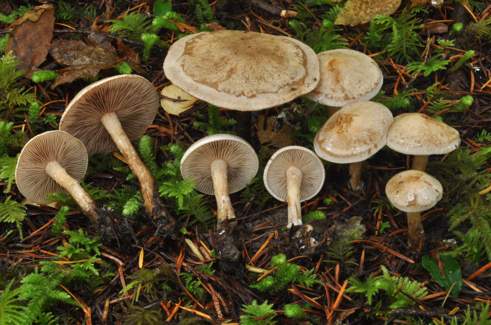 Hebeloma parcivelum (Photo: N. Siegel)
Hebeloma parcivelum (Photo: N. Siegel)Taxonomy
Full name: Hebeloma parcivelum A.H. Sm., V.S. Evenson & Mitchel, The Veiled Species of Hebeloma in the Western United States: 106 (1983)Genus: Hebeloma
Section: Scabrispora
Types: UNITED STATES: Oregon: W of Wapinitia Summit, Cascades, Wasco County (approx. 45.2267°N, 121.6963°W, alt. approx. 1200 m a.s.l.) on boggy soil in alder thicket under Alnus sp., 24 Sep. 1946, A.H. Smith (23703) (Holotype. herbarium acc. no. MICH 5557, HJB1000458).
- arrow_drop_downarrow_drop_upEtymology
- arrow_drop_downarrow_drop_upOriginal diagnosisPileus 3-7.5 cm latus, conicus demum plano-umbonatus, viscidus, ad marginem gossypinus, glabrescens, pallide argillasceus demum brunneomaculatus; odor et gustus mitis. Lamellae avellaneae deinde cinnamomeae, adnatae, latae, confertae. Stipes 6-8 cm longus, 8-12 mm crassus, deorsum brunnescens. Velum sparsim, pallidum. Sporae 7-10 x 5-6 μm, subleves, dextrinoideae, inequilaterales. Cheilocystidia 20-30 x 5-6.5 μm, filamentosa vel fusoid-ventricosa. Hypodermium pileorum nullum.
- arrow_drop_downarrow_drop_upEnglish translationPileus 3-7.5 cm broad, conical then applanate-umbonate, viscid, cottony on the margin, becoming glabrous, pale argillaceous then with brown spots; smell and taste mild. Lamellae hazel brown then cinnamon, adnate, broad, crowded. Stipe 6-8 cm long, 8-12 mm thick, discolouring brown downwards. Veil sparse, pale. Spores 7-10 x 5-6 μm, almost smooth, dextrinoid, inequilateral. Cheilocystidia 20-30 x 5-6.5 μm, filamentous or fusoid-ventricose. Pileus hypoderm absent.
References
Description
- arrow_drop_downarrow_drop_upThresholds
Description of Hebeloma parcivelum based on 6 collections
- arrow_drop_downarrow_drop_upMacroscopic descriptionPileus: (25) 46–52 (75) mm diameter; shape often convex, occasionally umbonate or weakly umbonate; characters often pubescent, remains of universal veil or spotting; margin characters occasionally involute, scalloped or smooth; viscosity tacky when moist; colour variation often unicolour or two color; colour at centre occasionally greyish buff, cinnamon, pale pinkish buff or cream.
Lamellae: attachment often emarginate, occasionally adnate; maximum depth up to 5 mm; number of complete lamellae 64–76; presence of tears absent; white fimbriate edge often weak, occasionally absent.
Cortina presence: no.
Stipe: (41) 53–68 (80) x (5) 6–9 (12) {median} x (5) 6–14 (15) {basal} mm; stipe Q 5.9–10.1; base shape often cylindrical, occasionally clavate; floccosity often pruinose at apex, occasionally fibrillose or floccose at apex; rooting no; thick rhizoids at base absent;
Context: Texture firm; stipe interior Not recorded; stipe flesh discolouring usually yes, occasionally very strongly; slenderness measure 6.4–12.1; smell odourless; taste often weakly bitter or none where recorded.
Spore deposit colour: brownish olive.
Exsiccata characters: Not recorded.
- arrow_drop_downarrow_drop_upMicroscopic descriptionSpores: shape amygdaloid, occasionally limoniform; colour in microscope yellow brown; guttules yes. papilla usually no, occasionally yes; Spore Code: O2 O3; P1 P2; D2 D3.
Basidia: (22) 23–30 (31) x 5–7 μm; ave. Q 3.8–4.1; spore arrangement 4 spored;
Cheilocystidia: main shape cylindrical; special features observed occasionally septa, bifurcate, branching, short or sparse; cheilocystidia ratios: A/M = 0.98–1.15; A/B = 0.95–1.24; B/M = 0.88–1.12.
Pleurocystidia: none seen.
Ixocutis: epicutis thickness (measured from exsiccata) up to 190 μm; ixocutis hyphae width up to 6 μm; ixocutis hyphae encrustation no; shape of trama elements beneath subcutis cylindrical or thickly sausage-shaped up to 11 μm wide.
Caulocystidia: Similar to cheilocystidia but larger, up to 75 μm.
- arrow_drop_downarrow_drop_upSpore measurements
- arrow_drop_downarrow_drop_upCheilocystidia measurements
- arrow_drop_downarrow_drop_upHabitat and distributionHebeloma parcivelum's preferred habitat appears to be mixed woodland with mossy soil or soil. Where only one possible associate was recorded, the most commonly recorded associate was Abies (33.3%) but Alnus (33.3%) and Tsuga (33.3%) were also recorded. In these cases the most commonly recorded families were Pinaceae (75.0%) and Betulaceae (25.0%). We have additional records where Betula (33.3%), Larix (33.3%), Picea (33.3%) and Pseudotsuga (16.7%) were recorded as possible associates, but in these cases a number of possible associates were mentioned. Overall the most commonly recorded families are Pinaceae (83.3%) and Betulaceae (50.0%) The growth habit of our collections was often gregarious and occasionally scattered.
According to our current collections, the species is found only in Northern America. On the continent, collections has been found in the WWF biomes The World Wildlife Fund (WWF) have divided the world into 867 terrestrial ecoregions. The ecoregion here is estimated by mapping from the GPS coordinates of the collection using data made available by Dinerstein et al (2017). Use this webtool to explore the ecoregions visually or see a full list of current ecoregions on Wikipedia. temperate conifer forests (50.0%), unknown biome (33.3%) and boreal forests/taiga (16.7%), specifically including the ecoregions: Unknown region (33.3%), Central-Southern Cascades Forests (33.3%), Eastern Canadian forests (16.7%) and Central Pacific Northwest coastal forests (16.7%). From collector information, it appears collections have been found in the 1.4 Forest – Temperate (83.3%) and 5.3 Wetlands (inland) – Shrub dominated wetlands (16.7%) IUCN habitats We map from the collector's description of the habitat to the International Union for Conservation of Nature (IUCN)'s definition using a standardised set of rules. Please see this page for a full list of IUCN habitats.. Within Northern America we have records from Eastern Canada (Newfoundland and Labrador), Northwestern U.S.A. (Washington and Oregon) and Western Canada (British Columbia).
Geographic distribution
Phenology
- arrow_drop_downarrow_drop_upAdditional cited collections